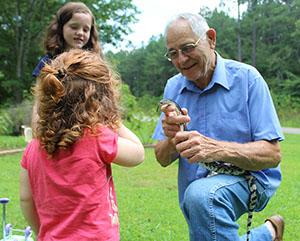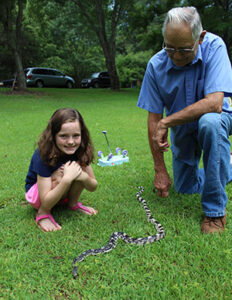Narrated and written by Dr. Zachary I. Felix, associate professor of biology at Reinhardt
Sitting in his white antebellum house in Cherokee county, Tommy McFarland tells me about the first bull snake he ever saw:
“I was by myself. We lived down there on Mack Chastain’s place (in Nelson). I was 11-year-old then. I walked out in the woods to get some firewood with an axe. I was walking around looking and something went “whoosh.” I looked down and there was a pine snake about that big around coiled up in the leaves. I walked right up on it. It blowed at me, and I throwed down the axe and run.”
He would go on to find many more of these snakes during his childhood.
 “Me and Harold Hammontree used to walk around in Nelson and scare the girls with them. We caught a great old big one one time and wrapped it around our neck, and it’d wrap around your arms. It stunk to start with until it got used to us, after it got used to us it didn’t smell at all. The biggest one I ever saw I was with Daddy down in the bottoms. You know how old dirt roads have just the two tracks. This snake was stretched clear across the road with its head in the bushes on one side and its tail on the other. I wished I could’ve caught and held that one.”
“Me and Harold Hammontree used to walk around in Nelson and scare the girls with them. We caught a great old big one one time and wrapped it around our neck, and it’d wrap around your arms. It stunk to start with until it got used to us, after it got used to us it didn’t smell at all. The biggest one I ever saw I was with Daddy down in the bottoms. You know how old dirt roads have just the two tracks. This snake was stretched clear across the road with its head in the bushes on one side and its tail on the other. I wished I could’ve caught and held that one.”
Pituophis Melanoleucusnorthern – Northern Pine Snake
The animal Tommy speaks fondly of is the northern pine snake (Pituophis melanoleucus), often called the bull snake. This name likely comes from the snake’s unique ability to blow or hiss loudly—a sound, as Mr. McFarland has shown, even 60 years later, one will not soon forget. This is a large snake, thick-bodied and stretching to lengths over 6 feet. The snake’s color is a black pattern on a cream-yellow to white background. The color pattern is very bold for such a large snake, and begins as a series of bands or saddles on the tail, becoming more of a checkerboard pattern in the middle of their body, with lots of dark markings towards their head.
Changing Habitats in the Region
In talking with other folks who grew up in north Georgia during the 1950s and 60s, I often hear that while they have not seen a pine snake in many years, they used to see them in farm fields often when they were young. These conversations and my own observations have led me to believe that pine snakes were a fairly common inhabitant of rural areas of North Georgia in the past. This is likely due to changes to the snake’s habitats in the region.

Tommy McFarland teaches his great-granddaughters about northern pine snakes. Mr. McFarland told me that “Kids don’t even know one tree from another. We knew everything that was out in the woods when I was a kid.”
According to Dr. Ken Wheeler, Reinhardt professor of history, “The forested landscape of northern Georgia today is tremendously different from what existed just decades ago. In 1940, for example, Cherokee County had well over 1,000 working farms. And many trees were part of orchards. Cherokee County farms at that time had over 31,000 apple trees, and another 25,000 peach trees. The situation was similar over most of the northern part of the state.”
Mr. McFarland adds that “The woods around here used to be a lot cleaner than they are because they got burned off every year. It kept the undergrowth off and then when a fire did get started it didn’t kill the big trees. But there were more berries, things to eat, simply because they burned the woods off”.
“Good Old Days” Kind of Animal
I have come to think of the northern pine snake as an emblem of rural north Georgia; a species associated with dirt roads, working forests, and small farms. They are a “Good Old Days” kind of animal. Along with other species such as bobwhite quail and fox squirrels, are pine snakes part of a vanishing community of days gone past, or can we preserve this important species? How common is the species in our region? What kinds of habitats do they use?
Seeking Insight and Help from North Georgia Communities
As part of my research here at Reinhardt, I am looking for answers to these questions. You can help me in these efforts by sharing what you know about pine, or bull, snakes. Have you ever seen one? If you have old photos I would love to see them. If you see a pine snake, even one run over by a car, please take a picture of it and share it with me. These pictures are valuable because they serve as a permanent record of the snake’s presence at a time and place.
Pictures or questions can be sent to my email at zif@reinhardt.edu Also, please visit our “Project Pine Snake” Facebook page and our website http://blogs.reinhardt.edu/projectpinesnake/ to see more pictures of pine snakes and their habitats.

